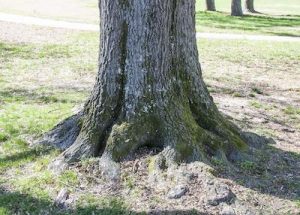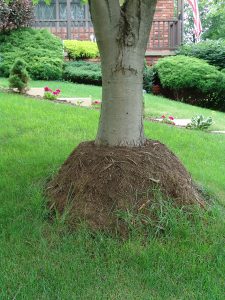The Importance of Root Flare for Tree Health
By Beverly Anderson, Fairfax Master Gardener

Root flare on a large oak
The original focus of this article was to be about root flare because it is so important for tree health. However, after researching root flare, it became apparent that other roots need to be included along with their benefits, problems and how they relate to trees.
Trees are vital to our ecology and are the largest plants on earth. Coast Redwoods, the earth’s tallest trees (Sequoia sempervirens) are found in Redwood National and State Parks. The tallest redwood is 380 feet high and the widest tree is 29.2 feet, the length of two VW Beetles. A silver maple (Acer saccharinum) in Fairfax County was named a Virginia National Champion in 2019 and Co-Champion in 2020 as registered in the Virginia BIG Trees program. Last measured in 2019, the tree was 96 feet tall with a crown of 112 feet.
In addition to storing carbon and giving us oxygen, trees stabilize the soil, clean the air, provide shade, offer habit and food for wildlife and more. They need optimum growing conditions for their sustained growth. It can take decades for a tree to become a majestic maple or a mighty oak.

Overmulch at root flare
On a recent walk through my neighborhood, I noticed that many of the trees were not planted at the proper depth or nurtured for a healthy future because no root flares were visible. Some had mulch piled 2 feet high against the stem (trunk) and looked like telephone poles sprouting from piles of mulch. Others resembled telephone poles planted in various places in the yards. Still others were surrounded by multiple roots curving around the stems and over the root flares. Foot-high planters filled with small shrubs and flowers surrounded a few trees. Several homeowners roped off areas around the trees, attempting to grow turfgrass.
What is wrong with those plantings, you ask? The trees leaf out in the spring and do not topple over in high winds. They are mulched to keep weed growth to a minimum. The leaves provide shade for the humans, animals and plants, and the germinated seed shows new bright green blades of turfgrass. All of that is true; however, while not obvious, the trees are struggling.
In the scenarios above, none of the root flares (also called trunk flare, root crown and root collar), of the trees were visible. The root flare is where the stem curves out at the base of the tree at the soil line and meets the roots. Mature deciduous trees have large obvious root flares. The root flare should not be confused with the swollen trunk area of a graft union.
The root flare is the beginning of the root system that is made up of two types of roots, nonwoody and woody, both of which are underground. Nonwoody roots are often called feeder roots that extend out to the drip line and beyond. Ash is one example that has extensions of root hairs, increasing the surface area. These roots are responsible for the uptake of water and nutrients and are contained in the first few inches of soil. Woody roots can be structural, tap, girdling and buttress, to name a few. Large structural roots are located 8 to 12 inches below the soil surface and grow radially and laterally. They are distinct for each species. These lateral roots stabilize the tree, anchoring it in the soil.

Girdling tree roots on maple
Girdling roots circle the tree, crossing and growing over the root flare. As the tree grows, so do the girdling roots, eventually strangling the tree. If the tree is planted too deeply, the girdling roots may be under ground. Girdling roots impede the flow of water and nutrients between the roots and the leaves. Tap roots grow straight down from the stem. Buttress roots are found in the rainforest, sometimes growing to 15 feet tall. They provide support for the tree as well as being a conduit for nutrients. The soil of the rainforest is very poor, with most nutrients remaining at soil level.
It is no surprise to arborists that trees arriving from the nursery planted too deeply in their containers with no visible root flare. They are then planted too deeply in the landscape and ultimately fail. It is crucial that trees are planted with the appropriate preparation and at the correct depth to thrive. Just as it can take decades for the oak to become mighty and the maple to become majestic, it can take decades for trees to slowly die.
 The root flare is critical to the health of the tree. Roots are adapted to being buried beneath the soil, but the root flare, graft union and stem should always be above ground. The root flare may be difficult to find on a young tree, but don’t give up! It is there.
The root flare is critical to the health of the tree. Roots are adapted to being buried beneath the soil, but the root flare, graft union and stem should always be above ground. The root flare may be difficult to find on a young tree, but don’t give up! It is there.
If the root flare is not visible in trees already planted in the landscape, carefully excavate the area next to the stem with small hand tools or the garden hose if you can tolerate the muddy mess. A stiff brush also works well. Spread the soil and/or mulch out away from the tree to form a level apron around the stem.
Root balls should be inspected prior to being placed in the planting hole. The root flare should be located and exposed if it is buried. Girdling and circling roots should be removed from the root ball prior to planting, as should all straps, string and synthetic burlap. Remove the top third of natural fiber burlap. Situate the root ball in the planting hole so that the root flare is 1 to 2 inches above the surrounding grade, backfill, water and mulch. In no time, the tree will become a beautiful specimen plant in your landscape.
References
• Show Me Your Root Flare, Ellen A. Vincent, Environmental Landscape Specialist, Clemson University
Horticulture Department
• Tree Troubles Usually Start at the Base of the Trunk, Christopher Enroth, University of Illinois
Extension, College of Agricultural, Consumer & Environmental Sciences
• Tree Root Systems, Sherry Rindels, Department of Horticulture, Iowa State University, Extension and
Outreach, Horticulture and Home Pest News
• Natural Root Flare, Roots and Planting Trees, Edward F. Gilman, University of Florida
• Buttress Roots, Learning about Rainforests, California Institute of Technology
• Coast Redwoods, Save the Redwoods League
• Virginia BIG Trees Program, Virginia Tech
• Why are trees so important?, Trees in the Regent’s Park and Primrose Hill, The Royal Parks, United
Kingdom
• Tree Planting Steps, CMG Garden Notes #636, David Whiting and Alison O’Connor, Colorado State
University Extension